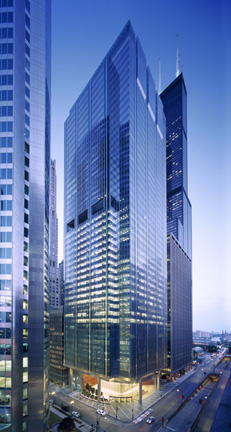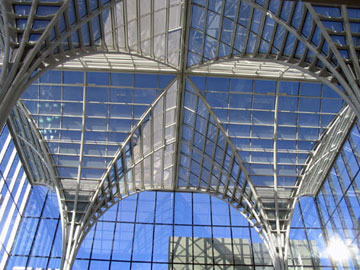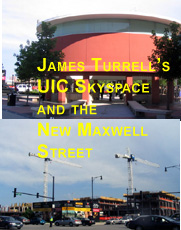| | 111 South Wacker, the new John Buck building designed by Goettsch Partners that, along with Pei Cobb Freed's Hyatt Center just across the street, seems to marking a resurgence in quality skyscraper design in Chicago after a long drought of abominable concrete condo towers, has garnered not one but two recent awards. Last month, it won one of the 2006 Awards of Excellence presented by the International Association of Lighting Designers, citing the lighting of its lobby, "A luminous ceiling bathes the  white core walls with a cool, diffuse northern light and accent lights provide more dramatic lighting effects at night. The lighting of the underside of the garage ramp reinforces the radial pattern using dimmable fluorescents in architectural coves. Radial slots were cut into the ceilings to integrate lighting equipment used to stimulate plant growth." Principal lighting designer on the project was Stephen Margulies, IALD, Cosentini Lighting Design, New York City, with lighting designer Fernando Soler also receiving credit. white core walls with a cool, diffuse northern light and accent lights provide more dramatic lighting effects at night. The lighting of the underside of the garage ramp reinforces the radial pattern using dimmable fluorescents in architectural coves. Radial slots were cut into the ceilings to integrate lighting equipment used to stimulate plant growth." Principal lighting designer on the project was Stephen Margulies, IALD, Cosentini Lighting Design, New York City, with lighting designer Fernando Soler also receiving credit. Then, on Saturday, June 12th, 111 South Wacker also walked off with the citation for Best Large Structure in the Structural Engineers Association of Illinois 2006 Excellence in Structural Engineering Awards for its engineers, Magnusson Klemencic Associates. (Department of full disclosure: I served as a juror for the final phase of the competition, a last-minute ringer, thoroughly outclassed by the illustrious company of Prof. Abbas Aminmansour of the U of I, Bruce Lake of McHugh Construction, Diane O'Keefe of IDOT, architect George Schipporeit, and the patrician Eli Cohen, Principal, Thornton-Thomasetti) The project began with at least two major hurdles. First, it was built on the site of Perkins & Will's 1963 United Gypsum Building, a nineteen story steel framed structure that was turned at a 45  degree angle to Wacker and Monroe. According to the description by Ira Bach in the 1980 edition of Chicago's Famous Buildings, it was "the most richly clad of all Chicago office towers," the columns covered in which marble, spandrels slabs of black slate, and glass tinted blue. The polyhedra shapes deployed in the ceilings emulated the crystalline structure of calcium sulfate - gypsum. The structure was demolished in 2003, over a decade after USG moved to the 1992 35-story tower designed for it by SOM's Adrian Smith. The site orientation of the razed building left behind a series of irregularly-placed caissons which Magnusson Klemencic still managed to use, adding new ones only when necessary, tieing together old and new caissons with a 10-foot thick mat foundation incorporating over 3,700 cubic yards of concrete. degree angle to Wacker and Monroe. According to the description by Ira Bach in the 1980 edition of Chicago's Famous Buildings, it was "the most richly clad of all Chicago office towers," the columns covered in which marble, spandrels slabs of black slate, and glass tinted blue. The polyhedra shapes deployed in the ceilings emulated the crystalline structure of calcium sulfate - gypsum. The structure was demolished in 2003, over a decade after USG moved to the 1992 35-story tower designed for it by SOM's Adrian Smith. The site orientation of the razed building left behind a series of irregularly-placed caissons which Magnusson Klemencic still managed to use, adding new ones only when necessary, tieing together old and new caissons with a 10-foot thick mat foundation incorporating over 3,700 cubic yards of concrete. The second hurdle for developer John Buck was the 15-story building directly to east of the site, which effectively blocked all views for the lowermost floors of any new structure. The first brawnily, radical design solved the problem by simply beginning the occupiable building 120 feet up, set on the central core and 20 massive diagonal braces. Although it was, of course, thoroughly engineered and perfectly stable, after 9/11, just the appearance of it was enough to scuttle the concept in favor of the one we see today, which, ironically, also incorporates some very creative engineering, but with the final appearance being the kind of rectangular tower that people - and tenants, more to the point - are accustomed to seeing. Those unrentable floors are now devoted to parking. In  what is perhaps the most spectacular aspect of the project's engineering, those seven parking floors hang from a series of three, 8-story mega-trusses, which themselves rest upon just six "concrete-filled pipe columns at street level, two per building side on three sides," - half the number that would normally be required, allowing for an exceptionally open, sweeping first-floor lobby, whose ceiling is defined by the bottom of the corkscrew parking ramp. what is perhaps the most spectacular aspect of the project's engineering, those seven parking floors hang from a series of three, 8-story mega-trusses, which themselves rest upon just six "concrete-filled pipe columns at street level, two per building side on three sides," - half the number that would normally be required, allowing for an exceptionally open, sweeping first-floor lobby, whose ceiling is defined by the bottom of the corkscrew parking ramp. Like Goettsch's previous Buck project, the USB Tower, the lobby is enclosed with a cable net wall system, but at 111 S. Wacker this becomes a "first-of its-kind elliptical" cable wall, with its 70 cables all stressed "to a different design tension depending on location, span, and wind loads. " The tensioning of the cables actually caused the plaza and third levels of the buildings to deflect slightly, for which additional sophisticated engineering analysis was deployed.The office floors are marked by three 61 and a half foot long composite girders, allowing for 60-foot clear spans with no internal columns, and six column-free corner offices on each floor. But this is one area where 111 S. Wacker's demolished predecessor actually had it beat. The 1963 U.S. Gypsum Building had no fewer than eight corner offices per floor. Other SEAOI Awards included: 2006 Best Medium Structure - Alfred Benesch & Company for the I-94 Modified Tied-Arch Bridge, located in Taylor, Michigan.  2006 Best Small Structure Award to The Structural Group, Ltd. for the Equinox Fitness Club in Chicago, Illinois. The below-grade space formerly occupied by the twin 900 North Cinemas was re-excavated for a new 30,000 square foot health club without disrupting bracing to existing basement walls that retained 7,500 tons of soil below Michigan Avenue. 2006 Best Small Structure Award to The Structural Group, Ltd. for the Equinox Fitness Club in Chicago, Illinois. The below-grade space formerly occupied by the twin 900 North Cinemas was re-excavated for a new 30,000 square foot health club without disrupting bracing to existing basement walls that retained 7,500 tons of soil below Michigan Avenue.
2006 Most Innovative Structure Award went to Thornton Tomasetti for The University of Chicago Graduate School of Business Hyde Park Center. While the engineering challenges were not as complex as those facing a number of other projects under consideration, the way the engineering was placed in service of Rafael Vinoly's elegant design underscored how, in addition to bravura gestures, superior engineering can be a matter of knowing when to stop. Join a discussion on this story lynnbecker@lynnbecker.com © Copyright 2006 Lynn Becker All rights reserved. | | |

 white core walls with a cool, diffuse northern light and accent lights provide more dramatic lighting effects at night. The lighting of the underside of the garage ramp reinforces the radial pattern using dimmable fluorescents in architectural coves. Radial slots were cut into the ceilings to integrate lighting equipment used to stimulate plant growth." Principal lighting designer on the project was Stephen Margulies, IALD, Cosentini Lighting Design, New York City, with lighting designer Fernando Soler also receiving credit.
white core walls with a cool, diffuse northern light and accent lights provide more dramatic lighting effects at night. The lighting of the underside of the garage ramp reinforces the radial pattern using dimmable fluorescents in architectural coves. Radial slots were cut into the ceilings to integrate lighting equipment used to stimulate plant growth." Principal lighting designer on the project was Stephen Margulies, IALD, Cosentini Lighting Design, New York City, with lighting designer Fernando Soler also receiving credit.  degree angle to Wacker and Monroe. According to the description by Ira Bach in the 1980 edition of Chicago's Famous Buildings, it was "the most richly clad of all Chicago office towers," the columns covered in which marble, spandrels slabs of black slate, and glass tinted blue. The polyhedra shapes deployed in the ceilings emulated the crystalline structure of calcium sulfate - gypsum. The structure was
degree angle to Wacker and Monroe. According to the description by Ira Bach in the 1980 edition of Chicago's Famous Buildings, it was "the most richly clad of all Chicago office towers," the columns covered in which marble, spandrels slabs of black slate, and glass tinted blue. The polyhedra shapes deployed in the ceilings emulated the crystalline structure of calcium sulfate - gypsum. The structure was  what is perhaps the most spectacular aspect of the project's engineering, those seven parking floors hang from a series of three, 8-story mega-trusses, which themselves rest upon just six "concrete-filled pipe columns at street level, two per building side on three sides," - half the number that would normally be required, allowing for an exceptionally open, sweeping first-floor lobby, whose ceiling is defined by the bottom of the corkscrew parking ramp.
what is perhaps the most spectacular aspect of the project's engineering, those seven parking floors hang from a series of three, 8-story mega-trusses, which themselves rest upon just six "concrete-filled pipe columns at street level, two per building side on three sides," - half the number that would normally be required, allowing for an exceptionally open, sweeping first-floor lobby, whose ceiling is defined by the bottom of the corkscrew parking ramp.  2006 Best Small Structure Award to The Structural Group, Ltd. for the Equinox Fitness Club in Chicago, Illinois. The below-grade space formerly occupied by the twin 900 North Cinemas was re-excavated for a new 30,000 square foot health club without disrupting bracing to existing basement walls that retained 7,500 tons of soil below Michigan Avenue.
2006 Best Small Structure Award to The Structural Group, Ltd. for the Equinox Fitness Club in Chicago, Illinois. The below-grade space formerly occupied by the twin 900 North Cinemas was re-excavated for a new 30,000 square foot health club without disrupting bracing to existing basement walls that retained 7,500 tons of soil below Michigan Avenue. 

